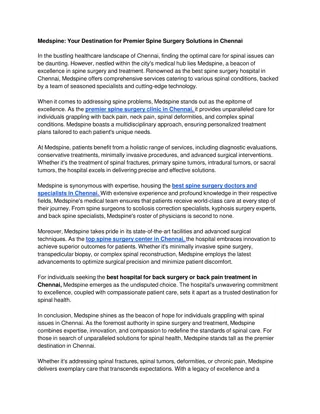
Minimally Invasive Spine Technologies Market
The global minimally invasive spine technologies market was valued at $3,180.9 million in 2022 and is anticipated to reach $9,406.5 million by 2032, witnessing a CAGR of 11.45% during the forecast period 2022-2032.nnRead Report Overview: //bisres
Download Presentation

Please find below an Image/Link to download the presentation.
The content on the website is provided AS IS for your information and personal use only. It may not be sold, licensed, or shared on other websites without obtaining consent from the author. Download presentation by click this link. If you encounter any issues during the download, it is possible that the publisher has removed the file from their server.
E N D
Presentation Transcript
Minimally Invasive Spine Technologies Market Size in 2022 and Growth Insights to 2032 | BIS Research Minimally invasive spine surgery (MISS) has become increasingly popular due to its ability to reduce surgical trauma and improve patient outcomes. By preserving normal anatomy, MISS often results in fewer complications, shorter recovery times, and a quicker return to daily activities. Technological advancements in surgical tools and techniques have played a crucial role in the widespread adoption of MISS, enhancing surgical precision and accuracy worldwide. According to BIS Research, the global minimally invasive spine technologies market was valued at $3,180.9 million in 2022 and is anticipated to reach $9,406.5 million by 2032, witnessing a CAGR of 11.45% during the forecast period 2022-2032.
Road Ahead The use of artificial intelligence (AI) in surgical robotic platforms will give companies new opportunities to make work safer, increase productivity, and save valuable time for people. AI is an attempt to minimize or even eliminate the risk of human error. The ongoing strenuous efforts to integrate artificial intelligence with surgical robotics will give rise to a new era of autonomous surgical robotics aimed at optimizing minimally invasive surgical performance and enhancing care. Recent Developments in the Global Minimally Invasive Spine Technologies Market In June 2022, NuVasive, Inc. launched its Singapore Experience Center aimed at supporting its expansion in the Asia-Pacific region and strengthening its global presence. In April 2022, SeaSpine introduced the Reef TA (TLIF Articulating) Interbody System, designed to precisely position an interbody device at the anterior portion of the spinal disc space to improve sagittal alignment and endplate support. This system provides various footprint and lordotic options, allowing surgeons to customize the procedure to meet specific anatomical needs. In October 2022, Orthofix and SeaSpine merged to form a prominent global entity in the spine and orthopedics sector. In July 2022, Medtronic plc secured FDA approval for the latest iteration of the UNiD Spine Analyzer, which features an advanced predictive model for degenerative spinal surgery. In October 2022, Captiva Spine entered into an exclusive strategic partnership with REMEX Medical to enhance their product portfolio in spine navigation and robotics. Request A Free Detailed Sample on Minimally Invasive Spine Technologies Market! Minimally Invasive Spine Technologies Market by Region North America and Europe have technologically advanced healthcare systems and allocate considerable budgets to the healthcare segment, due to which these regions hold the maximum share in the global minimally invasive spine technologies market. Regions such as Asia-Pacific, Latin America, and Middle East and Africa are anticipated to register significant growth during the forecast period 2022-2032 owing to factors such as rising preference for minimally invasive surgeries, rising geriatric population, and increasing demand to streamline surgical workflows. Key Drivers of the Minimally Invasive Spine Technologies Market: Rising Incidences of Spinal Disorders: Growing prevalence of conditions like herniated discs and spinal stenosis boosts demand for effective treatments. Preference for Minimally Invasive Surgeries: Patients and healthcare providers favor procedures with less recovery time and lower risks. Technological Advancements: Innovations in surgical techniques and tools enhance precision and outcomes in spine surgeries.
The market is expected to face some limitations due to the following challenges: Lack of Well-Established Landscape for Reimbursement for Minimally Invasive Spinal Procedures High Cost of Capital Equipment Purchases and Disposables Lack of Training Leading to Shortage of Skilled Professionals Future Trends in Minimally Invasive Spine Technologies Market 1. Robotic-Assisted Spine Surgery: The adoption of robotic systems in spine surgery is expected to grow significantly, providing enhanced precision and reducing human error. 2. Advancements in Imaging and Navigation: Innovations in 3D imaging and real-time navigation systems will continue to improve the accuracy of MIS procedures. 3. Expansion in Emerging Markets: As healthcare infrastructure improves in emerging markets, the adoption of MIS technologies is expected to rise, offering significant growth opportunities. 4. Personalized Medicine and AI Integration: The integration of artificial intelligence (AI) in preoperative planning and personalized treatment plans will further refine the outcomes of minimally invasive spine surgeries. Get Insights on Robotics and Imaging Market Research Reports Conclusion The minimally invasive spine technologies market is poised for significant growth, driven by technological advancements, rising patient demand for less invasive options, and the increasing prevalence of spinal disorders. While challenges such as high costs and the need for specialized training remain, ongoing innovations and expanding healthcare access in emerging markets offer promising opportunities for future growth. As the field continues to evolve, minimally invasive spine technologies will play a crucial role in improving patient outcomes and transforming spinal surgery.






















